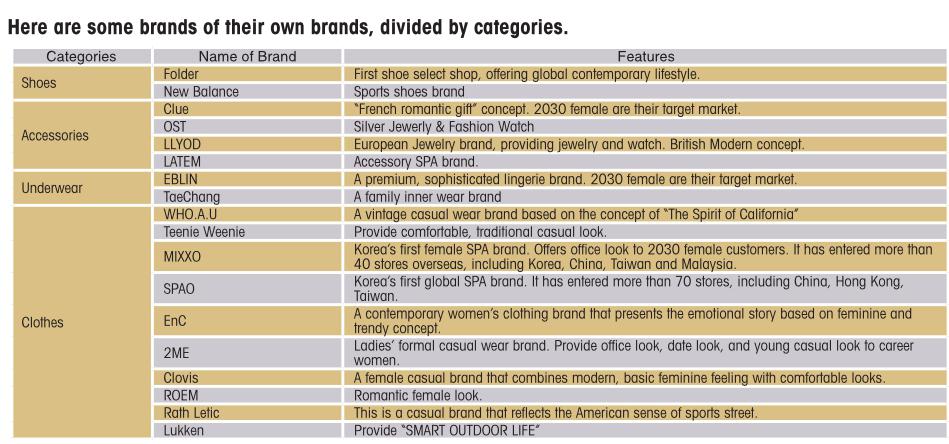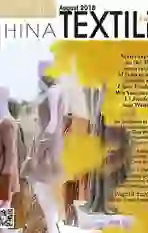Comparison of Ningbo Youngor Group & The E·Land Group
2018-10-11

Ningbo Youngor Group & The E-Land Group
Ningbo Youngor Group was founded in 1979 and in 1998 Youngor Group Company Limited was listed on the Shanghai Stock Exchange. On Forbes List it has ranked as 1,752 out of 2000 in global company, 858 in profit, 1894 in assets, and 1,809 in market value based on 2016 statistics. It has also ranked as number 117 as Chinas top 500 most valuable brands according to World Brand Lab in 2014.
Founded in 1980, the E·Land Group began with a fashion industry field based on the brand ‘E·Land and has expanded into fashion, distribution, leisure, dining out and construction field through mergers and acquisitions. It is also known as most successful Korean brands at launching their brand in China. It has expanded their business to worldwide. The map below shows the countries they expanded.
Similarities Diversified Development
Both companies not only have their business on fashion, but also owns diverse subsidiaries. It is working conglomerate.
First, Youngor groups main business in the garment manufacturing and retail market in Asia. They also engage in the design, manufacture, sale, and trade of clothing products and accessories. But not only that, its business also includes developing, leasing, and selling of condominiums and residential buildings, as well as operating hotels. It is also engaged in the provision of transportation, technical consultation, management, and investment services, and distributing and selling of electrical and thermal power. It even established zoo with companys name.
The E·Land group has six business field, which is food, retail, hotel&leisure;, construction, and entertainment. It owns about hundred subsidiaries in total.
Although both company works on diverse business field, their major business is focused on fashion industry. For example, Youngor Fashion Company, a subsidiary of Youngor Group, is primarily engaged in manufacture of apparels and textile products, as well as property development. Its major products are suits, shirts and casual wears, as well as woven fabrics. It has a network of more than 100 branch offices, more than 400 company-owned stores, and a total of 2,000 outlets across China.
According to Korean Company Evaluation analysis, E·Land group also has the largest share from the fashion industry (domestic and overseas) with 52 percent (59 percent) of its assets (sales). While the fashion industry is characterized as a domestic consumption industry, it is also diversified including China, the United States, and Europe.
Multi-brand Development
Both brands have developed multi-brand strategies. Just like Inditex, although they own different brands, all brands have different positioning and target markets. With this multi-brand development, they could increase their revenue while each brand sustains its own brand image. And their control system of all the brands are well-managed until now.
Youngor owns five brands: YOUNGOR, MAYOR, GT, HANP, and Hart Schaffner Marx. Each brand has different brand image. First, the main brand YOUNGOR, which means “Young and Energy”, mainly outstands its functionality. Its main target are 30 to 50 age of men. high-end brand MAYOR, which means “the mayors clothes” is positioned as high-end brand for family. It focuses on providing tailor-made products. GY brand is established in 2009. It means “Green Youngor”; and as you can guess from the meaning of the brand name, it aims at young men, building young concept. Its style is modern and fashionable. HANP provide self-developed green hemp products, emphasizes natural, healthy, eco-friendly lifestyle. The products are mostly focused on clothing, bedding, sanitary underwear and home furnishing series. And lastly, Hart Schaffner Marx is a memory of American leisure wind. It is being represented by Youngor in China market.
E·Land also owns diversified brands. Compared to Youngor, not only the number of the brands they own, but the range of fashion brands they own are broader.
Differences in Supply Chain Management
The globalization and diversification of the supply chain highlights the importance of global supply chain management nowadays. To react to these changes, both companies put their effort to operate their SCM effec- tively. However, the strategies they use are a bit different.
The E·Land Group
Originally, E·Land used outsourcing and they used 100% local suppliers in China to make products. Local suppliers were established mainly in Shanghai, Guangzhou, China. Later, as the company grew since 1990, it changed its outsourcing style to form a supplier cluster in Southeast Asia such as in Ho Chi Minh in Vietnam, and Colombo in Sri Lanka. They produce from minimum 30% to maximum 70% of their productions in these regions. It currently operates about 70 overseas supplier factories. This makes its supply chain management easier than ever.
It also built Asias largest fashion logistics center in Cheonan, Korea. As a result, it has more than doubled the speed at which it is shipped. It has five floors ranging from basement level 1 to the ground floor level 4, and every floor is capable of entering and leaving the vehicle. 150 11-ton trucks can be entered simultaneously, and the daily maximum capacity is 50,000 boxes. It is able to process 4 to 5 million boxes annually, and more than 5 trillion won (4.95 billion dollars) per year. In addition, it is equipped with a conveyor, which is 2.5 kilometers long, has more than 4,000 units of distribution system(DAS), making it possible to supply to more than 4,000 stores daily.
It also expects to save more than 10 billion won annually in logistical costs. This is because it incorporates logistics centers that were formerly scattered in Bupyung, Jiksan, and Iljuk, and South Gyeongsang in Korea. Cheonan, which has a fashion logistics center, is also a major transportation hub in Korea and has excellent access to Pyeongtaek Port, so it is expected to increase synergy with the production bases in Southeast Asia and the fashion industry in China.
E·Land company is also implementing Manhattans Supply Chain Commerce Solutions, which is number one global logistics system company, to help fulfil on its service promise to customers and enable future business growth. It helps optimise their supply chain operation and give them a highly flexible fulfilment capability. The implementation is being conducted by a joint team from Manhattan Associates, E·Land IT subsidiary E·Land Systems Ltd. and local Manhattan partner Value Chain Consulting & Technologies.
Youngor Group
Compared to E-Land, Youngor is more focused on building their own manufacturing system instead of finding suppliers. For example, in April 2007 Youngor group established the Hemp Industrial Investment and Holding Co. with Ningbo Yak technology Co., Ltd, Ltd in Yunnan province. Besides, Youngor Group, Yak Technology, and the Military Equipment Institute of the General Logistics Department of the Chinese Peoples Liberation Army have jointly established the China-Hemp Industrial Center. They pursued deeper research and development for China-Hemp cultivation, fiber production and yarn production.
They also established a R&D; department focusing on the hemp fiber, yarn, weavings, and the hemp terminal products. This would help them producing better products like socks, underwear, shirts, clothes, home textile made of hemps. Besides, the Group also put many efforts to produce high value-added and technology to their product.
This effort also refers that Youngor group have broader industrial extension on fashion industry since they also have business on garment, while the E·Land only focuses on selling clothes itself.
Conclusion & Suggestion
Essentially, from a corporate structural point of view, the two firms have very similar structures. I believe it is derived from the mood of the Asian business community. Because in Asian countries, it is able to see a single conglomerate expands its business field very often. However, the ways in which companies operate vary due to differences in corporate culture and its size of capital, so I predict the future and direction of the two companies are expected to differ. However, I found out that there was one thing they both were missing for each companys future, which is sustainability.
Of course, both companies try to show their effort to care about sustainability, but the way they do is very shallow. For example, the exhibition called “China-Hemp Family” was held by Youngor group and they showed their connection to the natural eco-friendly raw material. In addition, they started the hemp project since 2004, to aim to provide eco-products. However, this is only limited to one of their brand HANP. Moreover, ‘Dirty Laundry, a new investigative report from Greenpeace, has announced that the facilities Youngor group use for garmenting are releasing hazardous chemicals in China which will infect diverse hormone problems.
The E·Land Group as well, has announced its strategy to develop eco-friendly, functional, and practical products for its brand group (such as MIXXO, New Balance) at “2018 New Material Collection” held in Korea. But it also is limited at few materials, didnt expand to all of the processes of supply chain.
Consumers are willing to pay for sustainable fashion company. Especially millennials who are one of the main target market for many fashion companies, 66 percent of global millennials are willing to spend more on brands that are sustainable. Therefore, in order to obtain better vision of their companys future, I suggest urgent and transparent action is needed to improve their sustainable growth.
杂志排行
China Textile的其它文章
- Beyond Millennials:Understanding always-on Gen Z consumers
- What are the key points of Fabrics China 2019/20 A/W?
- Layout of industrial intelligent transformation and upgrading in Ningbo Haishu District
- CHTC FONG’S:Conquering global customers with international quality
- Rieter: Sales increase in the first half of 2018
- Yarn strength measurement–and protection against quality claims
